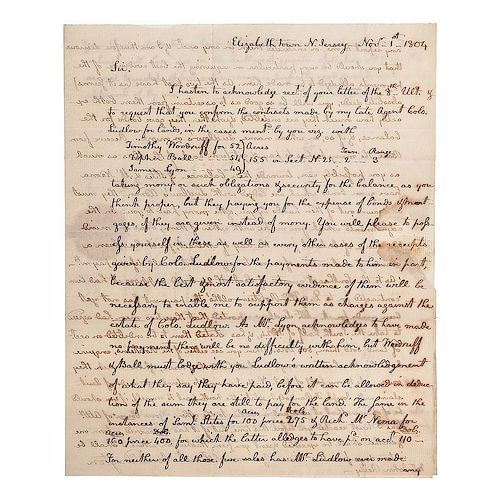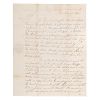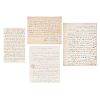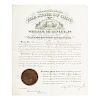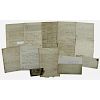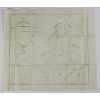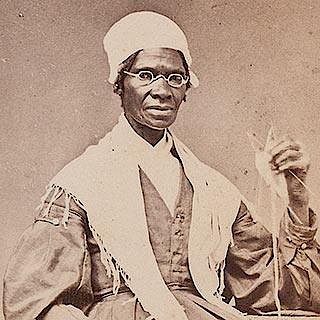Millikin Family Papers Incl. Appointments signed by Rutherford B. Hayes and William McKinley, the Last Will and Testament of
About Seller
6270 Este Ave.
Cincinnati , OH 45232
United States
With offices in Cincinnati, Cleveland and Denver, Cowan’s holds over 40 auctions each year, with annual sales exceeding $16M. We reach buyers around the globe, and take pride in our reputation for integrity, customer service and great results. A full-service house, Cowan’s Auctions specializes in Am...Read more
Two ways to bid:
- Leave a max absentee bid and the platform will bid on your behalf up to your maximum bid during the live auction.
- Bid live during the auction and your bids will be submitted real-time to the auctioneer.
Bid Increments
| Price | Bid Increment |
|---|---|
| $0 | $25 |
| $500 | $50 |
| $1,000 | $100 |
| $2,000 | $250 |
| $5,000 | $500 |
| $10,000 | $1,000 |
| $20,000 | $2,500 |
| $50,000 | $5,000 |
| $100,000 | $10,000 |
About Auction
Jun 9, 2017 - Jun 10, 2017
Cowan's Auctions dawnie@cowans.com
- Lot Description
A collection of approx. 34 papers from Hamilton, OH, ca 1801-1893. Much of the archive consists of papers related to or written by some of Hamilton’s “founding fathers” as well as papers belonging to the Millikin family, who played an important role in the history of Hamilton and the state of Ohio.
Items include: 2 letters related to John Reily, including an 1801 ALS from Secretary of Treasury Albert Gallatin, Hamilton land sales, and other business dealings; 7 documents, letters, and bills related to Daniel Millikin and his sons Minor and John M. Millikin including Rutherford B. Hayes DS and William McKinley DS as Governors of Ohio making Daniel "Dan" Millikin and John Millikin Trustees of Miami University; 3 documents related to Paul Huston; 3 documents related to John Woods and his business interests in the Little Miami River; autograph of famed illustrator Robert McCloskey; and miscellaneous papers.
In 1791, Fort Hamilton was the last line of defense into Indian country. By 1800, the army abandoned the fort but some settlers remained. Hamilton gradually grew into a profitable town that depended on the steady currents of the Miami River. Local historians credit the city’s development to several men. A few were John Reily, Dr. Daniel Millikin, and Johnathan Woods.
John Reily devoted his life to the pen and state government. Before he assisted writing the Ohio Constitution, Secretary of Treasury Albert Gallatin authorized Reily to become John Cleeves Symmes’s clerk for lands lying between the Miami River in Northwest Ohio for three terms (Gallatin, Treasury Department, October 9, 1801). Reily settled in the area after his first appointment in 1799. After living there for two years, he hoped to purchase 155 acres of land from land speculator Johnathan Dayton (Johnathan Dayton, Elizabethtown, New Jersey, November 1, 1801). Reily endeavored to expand his land holdings again in 1805 and attempted to purchase more land from Dayton. Some disputes over Israel Ludlow’s surveying errors complicated the sale. Exasperated, Dayton wrote to Reily to purchase the plots however as you think best, I shall be perfectly satisfied (Cincinnati, April 29, 1805). Two years after Reily’s purchase, another prominent member of Hamilton society moved into town, Dr. Daniel Millikin.
Daniel Millikin was the first permanent physician to settle in the area in 1807. Life as a pioneer doctor was busy and uncomfortable. Being the only doctor for at least 25 miles, he endured extensive travel on horseback through inclement weather and exposed himself to many communicable diseases. He suffered ill health for most of his life. Nonetheless, he treated his patients well and fathered sixteen children.
Johnathan Woods came “late” to the area in 1819, but almost immediately impacted the city. He established a law practice, and, within a year, served as a county prosecuting attorney. In 1825, he went to Washington as the representative for Butler and Warren counties. From the capital, he wrote to Dr. Daniel Millikin’s son, John, about a pressing issue with American Indians in Georgia. When the president sent his message a negotiation was pending with the Indians the result of which it was hoped would supersede the necessity of bringing the matter before us for investigation but that hope as we are informed is at an end, wrote Woods (Washington, December 30, 1825). Compared to Georgia and other newly established states, Woods felt optimistic about Ohio’s prospects. Near the end of his letter he wrote, I am more fully than ever convinced that Ohio is destined to one of the most prosperous states (Washington, December 30, 1825). After leaving Washington, he returned to Hamilton and operated several profitable businesses.
While each of the community builders had children that influenced the community, neither Wood's nor Reily’s children had more influence than Millikin’s sons, John M. (1804-1884) and Thomas (1808-1873). Instead of pursing a career in medicine, John and Thomas followed a path similar to Johnathan Woods. Both earned their law degrees and developed successful law practices. Thomas’s work moved him out of Hamilton, but John elected to stay. He earned his law degree at Washington College and was admitted to the bar in Ohio on September 5, 1827. He entered a partnership with William Bebb and continued to practice law until Bebb left to serve as Governor of Ohio in 1846. After losing his partner to politics, he retired to his farm and became heavily involved in agriculture and business. The allure of Washington eventually captured Millikin. He exited retirement and ran for the office of Ohio State Treasurer in 1876. After earning the nomination, he served for two terms (William Allen signed appointment, January 27, 1877). While serving as Treasurer, Governor Rutherford B. Hayes appointed him a trustee of Miami University (Rutherford B. Hayes signed appointment, May 3, 1869). Millikin ran for a third term as Treasurer, but lost the general election in 1878. Instead of continuing his political career, he chose to retire to his farm and family. Like his father, two of his sons made important contributions to the city. Dr. “Dan,” gave life to the city, and Minor sacrificed his.
Minor M. Millikin was John’s second born, but eldest surviving child. He attended Miami University in 1852 and matriculated from Harvard Law School. After earning his law degree, he chose to raise China pigs instead of arguments. Once the Civil War began, he left his wife, young son, and farm to join the army. He enlisted in the 1st Ohio Cavalry as a major and eventually earned the rank of colonel. An adept commander, he directed his men through Winchester, Cedar Mountain, Second Bull Run, and Stones River. Less than a month before his death, he authored a portent last will and testament on December 1, 1862. Instead of the adopting the traditional form, he opted to write a beautiful, deeply personal statement:
Death is always the condition of living, but to the soldier its immanency and certainty sums also the condition of its usefulness and glory, wrote Minor. It has been my habit always to keep a will, but as my last is uselessly long, and as to my human age, life seems less than ever likely to stay long with me, I will now write another. I have very little to say….to my most faithful, loving wife, Mary, I give all of my property of whatsoever kind….[including] my share due from my grandfather’s estate…there is not a single condition attached to this desire…I give all I have, and all I ever would have had to her….
On December 31, 1862 at Stone’s River, Millikin wheeled his regiment and led an unsupported sabre-charge against the enemy. As the enemy swallowed the regiment, Millikin reportedly engaged in a one-on-one sword fight with a rebel soldier. It ended when another Confederate soldier, Private John Bowers of Company K of the Texas Rangers, interrupted the contest by shooting and killing Millikin. Unable to sustain its position, the regiment fell back, leaving behind their leader's lifeless body. Hamilton newspapers among others wrote of his death. Whitelaw Reid wrote, “Justice never lost a more faithful champion, nor his country a more promising genius or heroic son…He lived long enough to die for his country, and who would have asked for a more glorious destiny?” (Whitelaw Reid, Ohio in the War, p 750.) After the battle, his men retrieved his body from the bloody field and delivered it home. He is currently interred at Hamilton.
John Millikin’s other son, Daniel, also known as Dan, opted to follow the example of his namesake. Dan was one of the most respected men in Hamilton. He was one of the first graduates of Hamilton High School and earned his degree in medicine at Miami Medical College in Cincinnati. He owned and operated a practice for over forty years in his hometown. In 1884, he joined the Miami Medical faculty and served as its first chair position of Medical Chemistry. Governor William McKinley appointed him a trustee at Miami University, continuing the tradition. Adding to his impressive list of accomplishments, he served as president of the Ohio Medical Association, president of the Hamilton Board of Education, and contributed many articles to literary and scientific journals. When he died in 1914, more than 500 people attended the memorial services.
Although much has changed in Hamilton, Dr. Daniel Millikin’s descendants remain important fixtures in the community and cherish their deep connection to their hometown to this day. The archive offered in the lot is a small part of their long, continued history and descends directly in the family.
Most of the documents range in condition from very good to relatively poor. The appointments are in excellent condition with brilliant original seals there are some folds and minor foxing on a few of the appointments. There are some papers with toning, brittle margins, and tears.Condition
- Shipping Info
-
SHIPPING. At the request of the buyer, Cowan's will authorize the shipment of purchased items. Shipments usually occur within two weeks after payment has been received. Shipment is generally made via UPS Ground service. Unless buyer gives special instructions, the shipping method shall be at the sole discretion of Cowan's Auctions, Inc.. Cowan's is in no way responsible for the acts or omissions of independent handlers, packers or shippers of purchased items or for any loss, damage or delay from the packing or shipping of any property.
-
- Buyer's Premium



 EUR
EUR CAD
CAD AUD
AUD GBP
GBP MXN
MXN HKD
HKD CNY
CNY MYR
MYR SEK
SEK SGD
SGD CHF
CHF THB
THB